
Hello everybody!
Ukrainians now have a slightly strange calendar. Today is the 19th day of the war. But I invite you to the recent past.
It was the third day of the war, February 26, Saturday.
On the morning of February 24, my country was attacked by neighboring Russia. In the first days, all Ukrainians, regardless of their place of residence, were very scared. My parents and I bought a lot of food and considered whether to evacuate to a remote village. We didn't know what to expect. Dad reassured that only military units or airfields would be fired. But from the beginning, orcs began bombing houses where civilians lived. It was there, in the East and near Kyiv.

It was quite calm in Lviv and I found myself in the center of the city, I had meeting there.
After saying goodbye to a friend, I decided to take a walk alone. The center of Lviv was almost empty. Locals either moved somewhere or stayed at home. Instead, refugees have only just begun to come here. They walked around the city, quiet and a little confused. In my thoughts I called them tourists, but immediately corrected myself: no, they are immigrants. They are not here out of good will. Almost all cafes were closed in those days, the windows were not lit. Silence everywhere.

Всім привіт!
В українців тепер трохи дивний календар. Сьогодні 19-й день війни. Але я запрошую вас у недалеке минуле.
Це був третій день війни, 26 лютого, субота.
24 лютого вранці на мою країну напала сусідня Росія. Перші дні усі українці, незважаючи на місце проживання, були дуже налякані. Ми з батьками купили багато продуктів і роздумували чи варто евакуюватись у село, яке знаходиться у глухому місці. Ми не знали, чого чекати. Тато заспокоював, що будуть стріляти лише і військові частини чи аеродроми. Але зі самого початку орки почали бомбити і будинки, де жили мирні люди. Це було там, на Сході і біля Києва.
У нас було доволі спокійно і я опинилась у центрі міста, мала там одну зустріч. Згодом вирішила прогулятися. Центр Львова був малолюдний. Місцеві жителі або виїхали кудись або сиділи по домах. Натомість біженці лише почали приїжджати сюди. Вони ходили містом, тихі і трохи розгублені. Подумки я називала їх туристами, але одразу виправляла себе: ні, це переселенці. Вони тут не з доброї волі. Майже усі кафе були у ті дні зачинені, вогні вітрин не горіли. Всюди тиша.

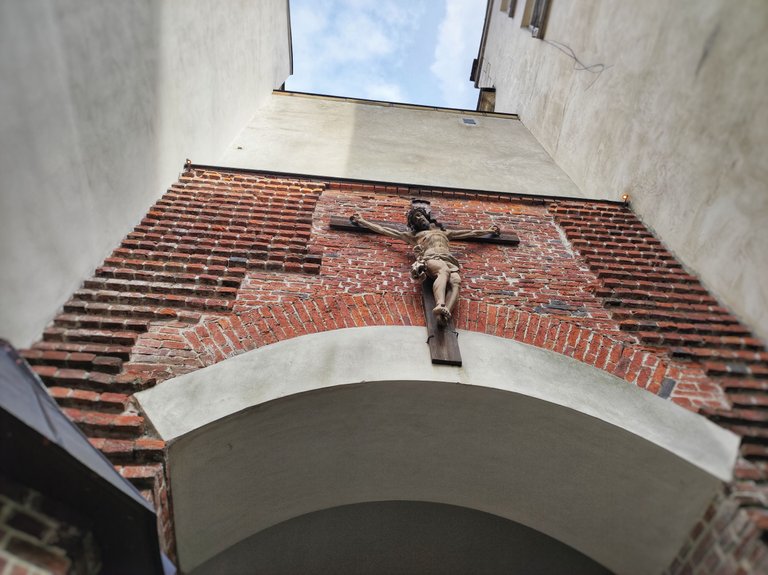
My feet led me to the old Krakowska Street, where there is an entrance to a beautiful church. Why not go there, because I have long dreamed of writing about it? So, I invite you to the Armenian Cathedral.
For me, this temple is like a pearl in a shell, because the building itself is hidden between the surrounding houses and the entrance is securely disguised in a small courtyard.
There was only one on duty in the church, and later two visitors came.
Darkness and mystery reigned here. I took photos of Art Nouveau frescoes, looked at the beautiful faces of angels and saints, the details of their clothes. I tried to remember some information about the temple, which I was given in the courses of guides in 2011... Unfortunately, the incredible oriental beauty of the interior did not bring joy to my soul. But it satiated my mind. Here are some historical facts about the cathedral.


Ноги привели мене на старовинну вулицю Краківську, де є вхід в один красивий та старий храм. Чому б не зайти туди, адже я давно мріяла про нього написати? Отож, запрошую вас у Вірменський собор.
Для мене цей храм схожий на перлину у мушлі, адже сама будівля захована між навколишніми будинками і вхід надійно замаскований у невеликому подвір'ї.
У церкві була лише чергова, а згодом зайшло десь двоє відвідувачів.
Тут панувала напівтемрява і загадковість. Я робила фото фресок у стилі модернізму, роздивлялась прекрасні обличчя ангелів та святих, деталі їхнього одягу. Це відволікало думки. Я намагалася згадати якусь інформацію про храм, яку мені дали на курсах екскурсоводів ще у 2011... На жаль, неймовірна східна краса інтер'єру не приносила радість моїй душі. Але насичувала розум. Ось кілька історичних фактів про собор.



Armenians have long lived on Ukrainian soil. They were often merchants and travelers, wealthy people. In Lviv, they had their own self-government body, court and code. In the 16th-17th centuries about 200 families lived here. The community gathered around its church, like other nations (Poles, Jews, Ukrainians). In 1367 the church became a cathedral, ie a religious center for Ukrainian and Wallachian (ie Romanian) Armenians.
The Cathedral of the Assumption of the Blessed Virgin was built in several stages. The temple was originally built between 1356 and 1370 at the expense of Armenian merchants Jacob of Kafa and Panos Abrahamovich on the site of an older wooden temple. The main architect of the building was Master Doring. Little is known about him (he was either Italian or German), but he knew well the traditions of Byzantine and Italian construction.
In 1381, Lviv and the cathedral in particular were badly damaged by fire. According to historians, its reconstruction lasted until 1437. During these works, arcades were added on the north and south sides of the church. In 1630, the Armenian bishop of Lviv Mykola Torosovych concluded a union with Rome and decided to enlarge the church. The reconstruction project was created by architect Wojciech Kilar. A massive nave was added to the 14th century church on the west side. In 1712, after another fire, the interior was renovated, including baroque altars and painted walls. The church became more like a Catholic one.


Вірмени здавна жили на українській землі, через скрутну ситуацію і війни на їхній батьківщині. Часто вірмени були купцями та мандрівниками, заможними людьми. У Львові вони мали свій орган самоврядування, суд та кодекс, право на ведення ремесел тощо. У 16-7 столітті тут жило десь 200 сімей. Громада гуртувалася навколо своєї церкви, подібно як і інші нації (поляки, євреї, українці). У 1367 церква стала Собором, тобто релігійним центром для руських та валахських (тобто румунських) вірмен.
Кафедральний собор Успіння Пресвятої Богородиці будувався у кілька етапів і це додало будівлі гармонії, краси і особливого шарму. Первісно храм був споруджений упродовж 1356—1370 років на кошти вірменських купців Якова з Кафи та Паноса Абрагамовича на місці дерев’яного вірменського храму. Головний архітектор будівлі був майстер Дорінг. Про нього збереглося мало даних (це був або італієць або німець), але він добре знав традиції візантійського та італійського будівництва.

У 1381 році Львів і собор зокрема, сильно постраждали від пожежі. На думку істориків, його реконструкція тривала до 1437 р. Під час цих робіт з північної та південної сторони храму прибудували аркади. У 1630 році вірменський єпископ Львова Миколай Торосович уклав унію з Римом і вирішив збільшити храм. Проект реконструкції створив львівський архітектор Войцех Кілар. До церкви XIV століття на західній стороні прибудували масивний неф. У 1712 році внаслідок ще однієї пожежі був оновлений інтер’єр, зокрема поставлені барокові вівтарі та розмальовані стіни. Храм став більш схожий на католицький.

The fresco depicts the funeral of a bishop, monks, and if you look closely, you can see ... ghosts. Apparently these are the souls of the dead.
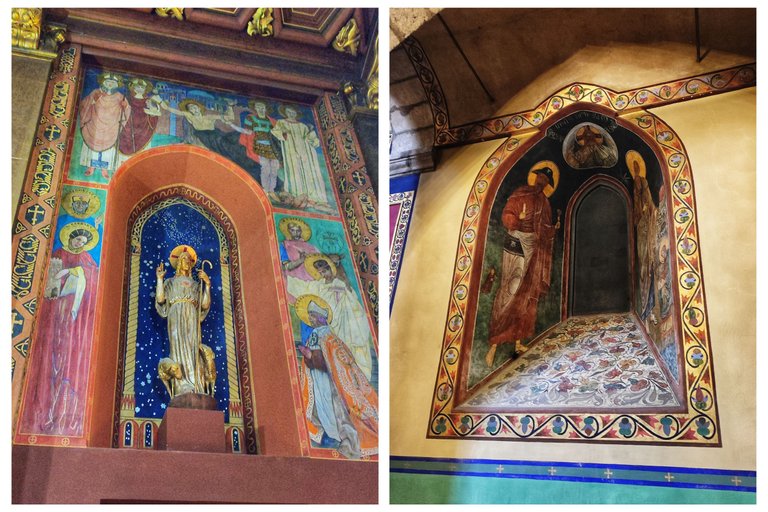

But what we see now in the interior is the result of a large-scale restoration that took place in 1908-1927. Architect Frantsysk Monczynski decided to dismantle the houses on the side of Krakivska Street and equip the entrance part.
At this time appeared a magnificent wooden carved ceiling in the nave, wall paintings and stained glass by the artist Jan Henrik Rosen, a mosaic by the artist Megoffer.
In 1953 (during Soviet atheism) the premises were turned into a museum and named after... Lenin. Most Armenians emigrated to Poland during World War II. Since 2000, the church again belongs to the Armenians.
Services are held every Sunday in Armenian, Ukrainian and Russian!


Але те, що ми бачимо зараз — це вже є результат масштабної реставрації, яка проходила у 1908-1927 роках. Архітектор Франциск Мончинський вирішив розібрати будинки зі сторони вулиці Краківської та облаштувати вхідну частину.
В цей час з'явилася розкішна дерев'яна різьблена стеля у наві, розпис стін і вітражі (художник Ян Генрик Розен), мозаїка в бані (художник Мегоффер). 1930 року за проектом Вітольда Мінкевича було виконано новий головний вівтар, престол та амвон.
1953 року (у часи радянського атеїзму) приміщення перетворили на музей і назвали на честь... Леніна. Більшість вірмен у часи другої Світової війни емігрували до Польщі. Уже в часи незалежної України, з 2000 року, церква знову належить вірменам. Донині тут діє громада відновленої Української єпархії Вірменської апостольської церкви. Відвідати службу в храмі можна щонеділі, причому є служби вірменською, українською і російською мовами!


This is the oldest part of the temple. Here we see the contrast between the gray stone walls and bright frescoes. The colors are quite bold, modernist.


In the painting of Golgotha we can see Christian saints. Famous people of that time became models. For example, St. Benedict is the Ukrainian Metropolitan Andriy Sheptytsky.


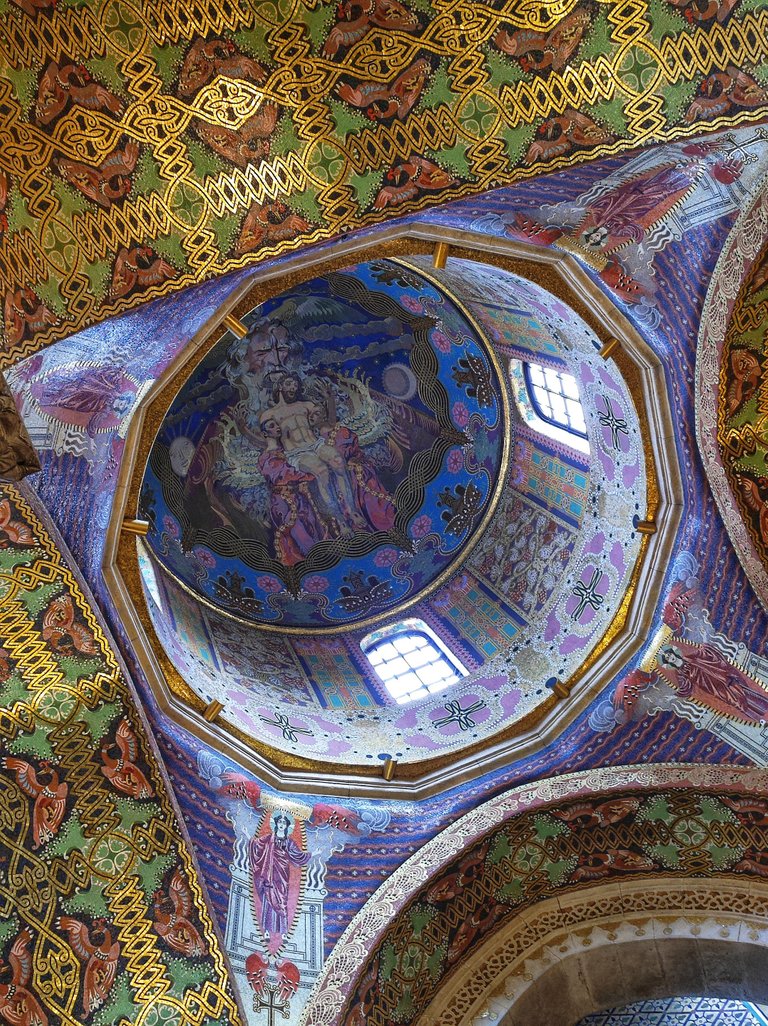
In the dome of the altar we see a very expressive and vivid image of the Holy Trinity. And what beautiful ornaments around! Gold leaf is used here.
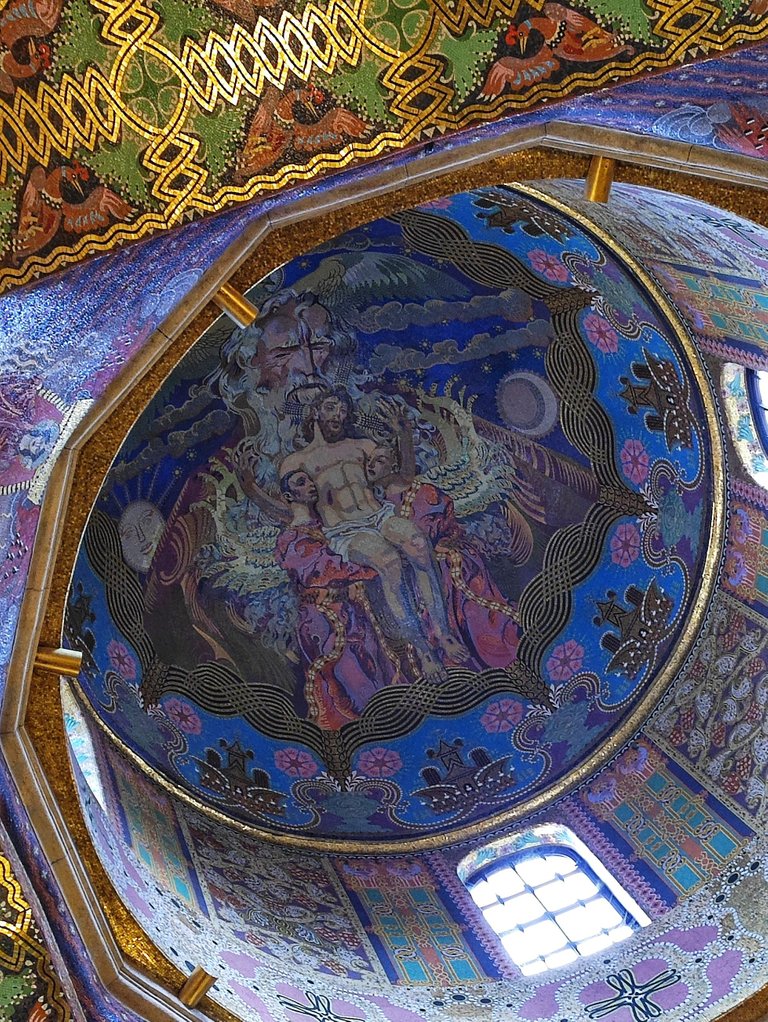


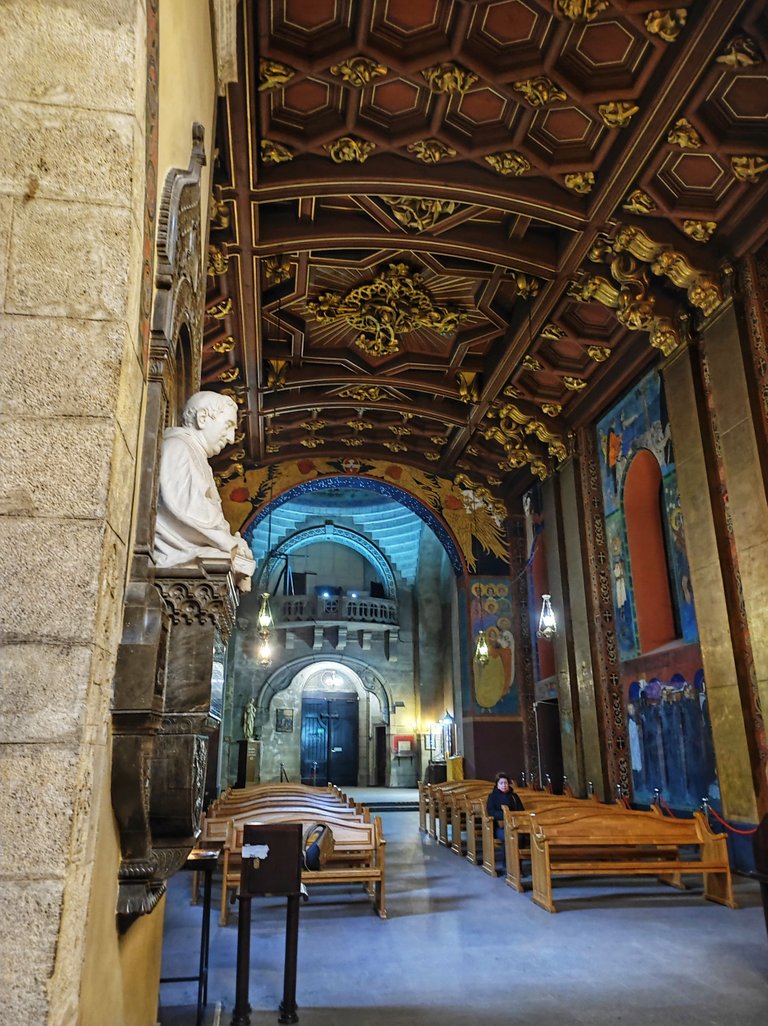

The peculiarity of Armenian architecture is the great attention to work with stone. These ascetic curves and lines seem to transport us to the distant past.


To see the church from another angle, we will go from Krakivska to Armenian Street.
Behind this gate was a cemetery where Armenian tombstones dating back to the 16th-18th centuries have been preserved. In the western part of the former cemetery there is a wooden chapel "Golgotha" of the 18th century. This is a very interesting and delicate work, but unfortunately this courtyard is always closed, so tourists can see it only from afar.
A sculpture of the Mother of God from 1664 from the former Kraków Gate, which was part of the city's fortifications, is placed in a niche of the fence.

Для того, щоб побачити церкву з іншого ракурсу, ми повернемо з Краківської на Вірменську вулицю.
За цією брамою був цвинтар, на якому збереглися вірменські надгробки, датовані 16-18 століттями. У західній частині колишнього цвинтаря є дерев’яна каплиця «Голгофа» 18 ст. Це дуже цікава і тонка робота, але на жаль цей дворик завжди зачинений, тому туристи можуть оглядати його лише здалеку.
В ніші огорожі розміщено скульптуру Богородиці 1664 року з колишньої Краківської брами, яка входила у систему фортифікацій міста.




From afar, our attention is drawn to an interesting and original three-tiered bell tower. It was built in 1571 according to the project of architect Peter Krasovsky on the site of the old one, which burned down in a large-scale fire in 1527 (then burned almost all of Gothic Lviv). What I like most are the decorative towers at the corners of the bell tower, as well as the protrusions of ancient stones in plaster.
Здалеку нашу увагу приковує цікава та самобутня триярусна вежа-дзвіниця. Вона споруджена у 1571 році за проектом архітектора Петра Красовського на місці старої, яка згоріла у масштабній пожежі 1527 року (тоді згорів майже весь готичний Львів і згодом сюди прийшов стиль Ренесанс). Найбільш мені подобаються декоративні вежі по кутах дзвіниці, а також виступи давніх каменів у штукатурці.


And now we will walk through the passage in the bell tower to the charming Armenian courtyard. To the right of the aisle is a door leading to the Green Sofa art gallery.
А тепер ми пройдемо крізь прохід у дзвіниці до чарівного Вірменського дворика. Справа у проході є двері, які ведуть у картинну галерею "Зелена софа".

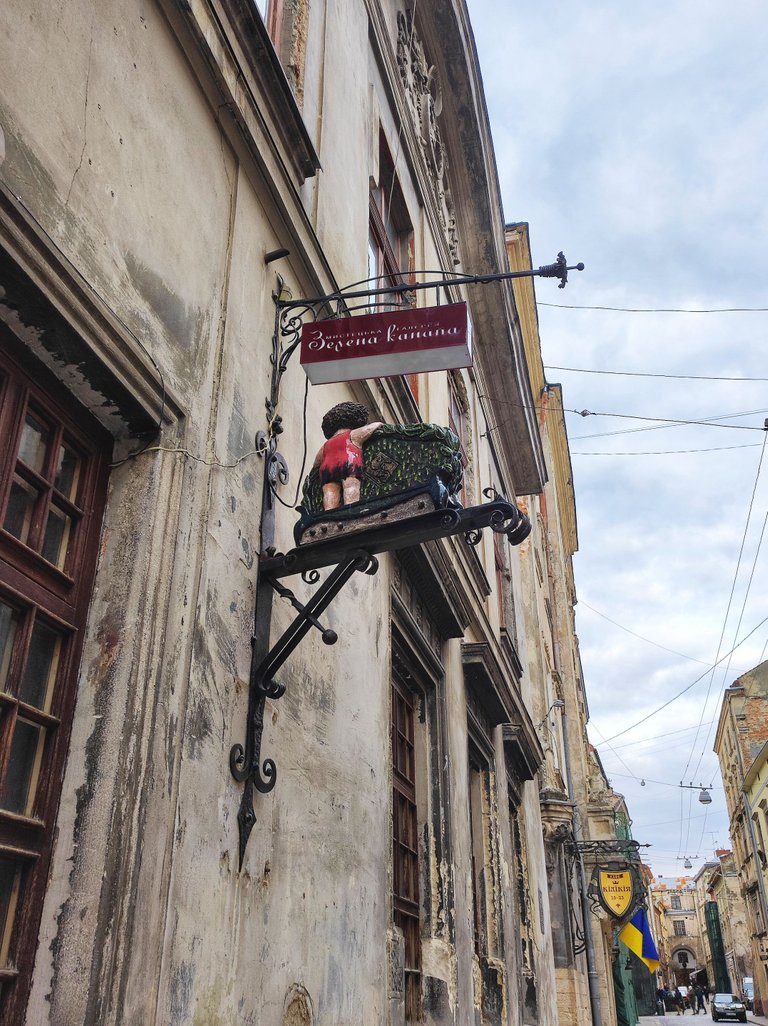


The oldest part of the cathedral impresses with its restrained beauty. From this perspective we can see the traditional for Armenian architecture 12-sided drum, tent top, round apse and beautiful stone carvings around windows.
Найдавніша частина собору вражає своє стриманою та аскетичною красою. З цього ракурсу можемо побачити традиційний для вірменської архітектури 12-тигранний барабан, шатрове завершення, круглу апсиду і прекрасну різьбу по камені.



Memorial column with a sculpture of St. Christopher.

This bright building in front catches the eye and beckons to come closer. It is a bank "Mon pius" founded in the 17th century on the basis of the Armenian Church Brotherhood. Here you could take a loan, hand over a thing to a pawnshop, or put money in an account and withdraw it in another city (this is especially useful, because then during the trip you could be robbed by robbers). Now a fashionable restaurant is located in part of the bank. In the yard of this restaurant there are sculptures of rich Armenians, the founders of this bank.
Ця яскрава будівля попереду приковує погляд і манить підійти поближче. Це є банк "Mon pius" заснований у 17 столітті на базі вірменського церковного братства. Тут можна було взяти позику, здати річ у ломбард, або покласти гроші на рахунок і зняти їх в іншому місті (це особливо корисно, бо в тоді під час подорожі вас могли пограбувати розбійники). Зараз у частині банку розташований модний ресторан (можливо я про нього розповім іншим разом). У дворі цього ресторану є скульптури багатих вірмен, засновників цього банку.




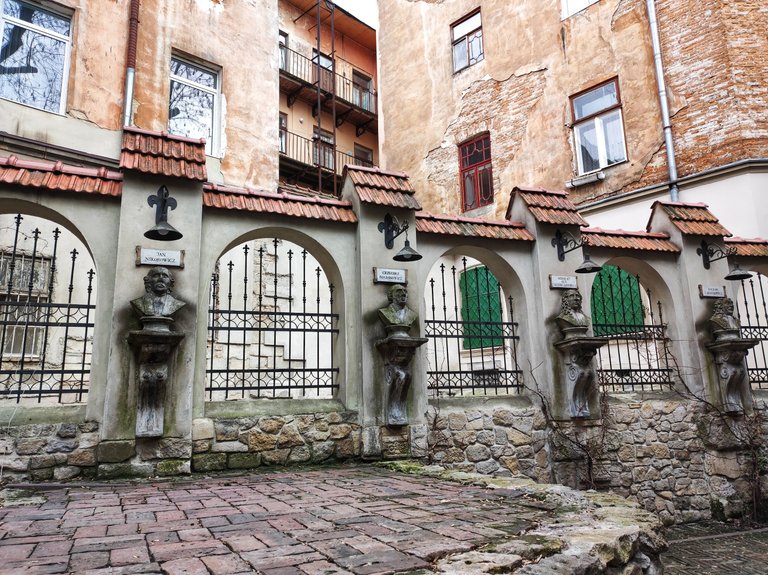
Through a low arch we leave the courtyard of the restaurant again on Armenian Street... Do you feel this spirit of antiquity?
In fact, Armenian Street is very interesting, there are many cafes and art galleries. So someday I'll tell you more about it.

Thanks for your visit and support.
Stay close. Stay with Ukraine!
I would very much like to invite you here when peace comes.


